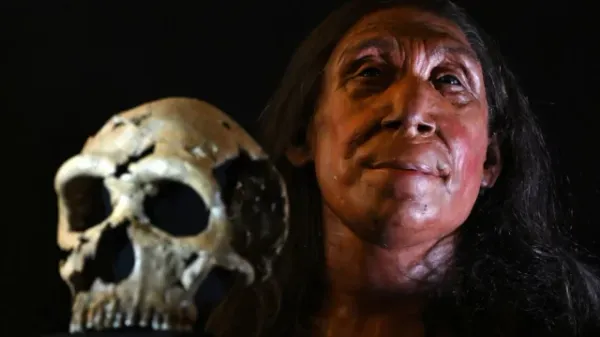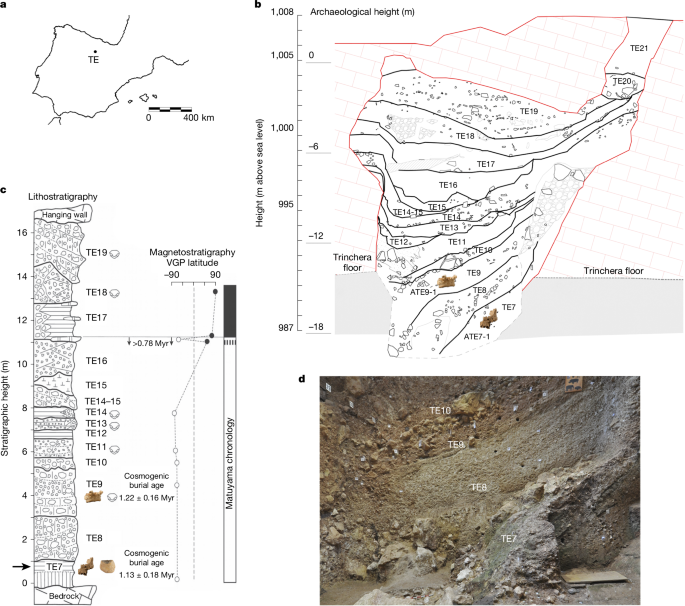Exploring the Ancient Human Face of Western Europe: Insights from Sima del Elefante





Sima del Elefante, located in the Atapuerca Mountains of Spain, has emerged as a keystone site for understanding early human presence in Europe. Spanning layers of history, this cave has gifted us profound insights into both the landscape and its ancient inhabitants. The study of fossil ATE7-1 offers an exciting opportunity to peer into humanity's ancient past, found at this remarkable site in the Sierra de Atapuerca. This face is among the oldest known in Western Europe, dating to the Early Pleistocene, providing invaluable insights into the anatomical features and environments that shaped early humans.
The lithostratigraphy of Sima del Elefante has revealed intricate sedimentary layers that hold fragments of our deep past. TE7, a significant stratum, brims with a complex mixture of silts, muds, and gravel indicative of the dynamic geological processes that shaped the cave's environment. These deposits, steeped in time, encapsulate the rhythm of ancient floods and sedimentation, hinting at a landscape that was constantly in motion. Located in the heart of the Sima del Elefante, the TE7 level is a repository of ancient secrets, with archaeological layers providing a timeline that reveals a world inhabited by diverse species.
Among the treasures retrieved from Sima del Elefante is a hominin face dating back to the Early Pleistocene. Its reconstruction offers a rare glimpse into the visages of our forebears, revealing metrics that align closely with early representatives of the Homo genus. Fossil ATE7-1 stands out for its comparatively small facial dimensions when juxtaposed with early and middle Pleistocene fossils across Africa, Asia, and Europe. The artistry in these reconstructions underscores the diversity within our lineage, bridging gaps between Neanderthals and modern humans.
What's particularly fascinating is the cautious yet revealing use of modern technology like virtual reconstructions and CT scans that allow us to peek into the dental intricacies and skeletal nuances of our ancestors. Researchers carried out virtual reconstructions, revealing a face that is crucial for understanding the morphological variations within the genus Homo. Fascinatingly, the specimen displays peculiarities in its maxillary sinus shape, similar to modern humans rather than Neanderthals, pointing to evolutionary nuances in early hominins.
The stone tools of TE7 reflect a deep understanding of material properties and tool-making techniques. The limestone and quartz artefacts unearthed here are not just objects; they are stories of survival, innovation, and adaptation. An experimental approach in archaeology aids us greatly in decoding these artefacts, bridging past and present manufacturing methods. The TE7 level has uncovered a remarkable collection of lithic artifacts featuring flint, quartz, and limestone, providing a fascinating glimpse into the tool-making traditions of early human ancestors in Western Europe.
The prime hallmark of the TE7 lithic assemblage lies in its raw material diversity. Flint and quartz were favored, perhaps for their abundance and durability, forming the basis for most tools. Intriguingly, the discovery of several limestone objects from the TE7 level, sourced from the Cretaceous substratum within the Sierra de Atapuerca, raises intriguing questions about the availability and use of local resources. Determining whether certain limestone pieces were deliberately knapped tools or naturally fractured rocks involved meticulous comparisons via an experimental archaeology program.
The assemblage from TE7 comprises a variety of tool types, each illustrating distinct stages of the stone tool production process. The collection includes cobble tools, complete and fragmented flakes, each with unique characteristics. Detailed examination of quartz artifacts through modern microscopy techniques even unveiled evidence of use on bone, adding an additional layer of complexity to our understanding of these ancient tools. The analysis of use-wear patterns on these artifacts offers a tangible link to the daily lives of their creators.
One remarkable discovery involved the identification of bone residues on a quartz cobble-core, pointing towards its use in processing animal materials. Similarly, some limestone pieces bear wear consistent with butchery activities, suggesting an active role in subsistence processes. Limestone artefacts, often overlooked, provide a unique perspective on human activity at TE7. Flakes and tools crafted from this abundant local resource suggest purposeful knapping and tool use.
The palaeoenvironmental data gleaned from TE7 paints a vivid picture of a world teeming with life and diverse habitats. From pollen analysis, it is evident that deciduous oak and fruit-bearing species like Prunus were part of the landscape during the period when TE7 was formed. These trees and shrubs likely provided both sustenance and shelter. Encompassing a patchwork of woodlands, open spaces, and waterways, the TE7 locale would have been an attractive habitat not only for humans but also for a variety of animals.
The presence of faunal elements like amphibians, reptiles, birds, mammals, and ungulates reflects a richly biodiverse ecosystem, indicative of fluctuating climatic conditions. Pollen and spores trapped in the sediment layers tell the tale of environmental shifts, hinting at episodes of aridity and moisture variability. Additionally, non-pollen palynomorphs suggest a landscape influenced by both natural fire events and human activities.
Though this research primarily focuses on archaeological finds, the fascination with ancient DNA underpins many questions we have as modern humans about our ancestors. The presence of various species, including prehistoric horses and hippos, paints a vivid picture of the world our ancestors navigated, replete with life and diversity. Among these discoveries include charismatic creatures like the hippopotamus and the elusive European macaque, each telling a tale of adaptation to varying landscapes and climates.
The archaeological excavations at level TE7 have unveiled an exciting snapshot of life in the Early Pleistocene. The faunal remains discovered here range from majestic beasts like Hippopotamus georgicus to nimble creatures such as roe deer, painting a vivid picture of a dynamic ecosystem. The TE7 level showcases an impressive array of fossils, with the mighty skeletal remains suggesting the presence of permanent water bodies necessary for these massive creatures.
Among the found relics, a rib fragment from a small-sized animal bears interesting anthropogenic modifications, hinting at the butchering practices of our early ancestors. This rib showcases cut marks that provide tantalizing clues to defleshing activities, offering a rare insight into prehistoric subsistence strategies and community lifeways. The landscape reconstructed from these faunal communities suggests varied environments within close proximity.
The exploration into the preservation and conservation of the TE7 site unveils a rich tapestry of archaeological and geological history. The fossilized fragments of ATE7-1, an ancient hominin specimen from the TE7 level, tell a story of delicate conservation efforts. This hominin relic, exhibiting a relatively intact midface, was unearthed with an astonishing state of preservation despite the omnipresent hazards of mineral deposition and geological ravages.
In the bustling field laboratory situated near the excavation site, meticulous cleaning and initial conservation efforts transpired. By using deionized water and delicate brushing, specialists revealed the structures essential for understanding ancient human physiognomy. Further enhancement of the preservation regimen occurred at specialized laboratories, where traces of root canals and fissures were observed with detail via microscopic examinations from numerous angles.
Although the concept of grave goods as understood in later historical contexts might not directly apply here, the artefacts found in TE7 certainly served as vital tools and perhaps even held symbolic significance. The relationship between these artefacts and the people who crafted them continues to captivate scholars, prompting further research into their origin, use, and meaning. The significance of the ATE7-1 and associated finds extends beyond their immediate archaeological value.
Each fragment, whether of bone or stone, each sediment layer and artefact, acts as a page in the grand history of human evolution. Together, they continue to unravel the story of our ancestors, offering perspectives that ground our contemporary understanding in the enduring narrative of humanity. Through the finds at TE7, a narrative of resilience and adaptability emerges. This archaeological site becomes more than an archive of fossils and stone tools; it transforms into a window through which we can glimpse the vibrant lives and landscapes of our human ancestors.
From mammalian behemoths to the tiniest amphibians, the TE7 level of the Sima del Elefante is a window into a world long gone, brought to life through intricate zoological and archaeological studies. These finds not only illuminate the ecological dynamics of prehistoric Atapuerca but also enrich our understanding of human evolution, offering a glimpse into the lifeways and environments of our ancient predecessors. While the technological prowess of these ancient individuals was undoubtedly sophisticated, the findings from TE7 showcase the ingenuity of early toolmaking and highlight the innovative ways researchers piece together the story of our ancient past.
As excavations and analyses continue, each artifact brings us a step closer to comprehending the everyday lives of these early Europeans, revealing the excitement and historical richness that makes archaeology such a fascinating field of study for anyone interested in understanding our shared human heritage.

Comments